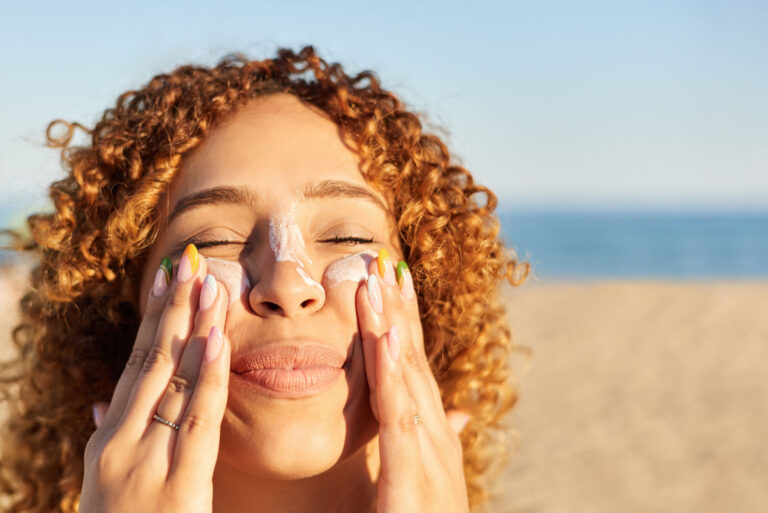Sunscreen is a crucial element in every skincare routine. It protects your skin from harmful ultraviolet (UV) rays, helping to prevent premature ageing and reducing the risk of skin cancer. Despite its benefits, many people are unsure about how SPF works and how to use sunscreen correctly.
SPF plays a vital role in shielding your skin from UV rays, even during everyday activities. Understanding how SPF works, what the numbers on the label mean, and how to apply sunscreen properly can make all the difference in keeping your skin healthy and protected.
While spending time outdoors, make sure to protect yourself by wearing protective clothing, hats, and sunglasses. Sunscreen is another key part of staying safe in the sun, and here’s what you need to know.
What Is SPF?
SPF, or Sun Protection Factor, represents how effectively a sunscreen protects your skin from UVB rays, which are primarily responsible for sunburn and skin damage. The SPF rating reflects the amount of time you can safely stay in the sun without burning, compared to if your skin were unprotected.
For example, if your skin burns after 10 minutes in the sun without protection, an SPF 30 sunscreen theoretically allows you to stay in the sun 30 times longer. However, this can vary based on factors like sweating, swimming, and proper application.
How to Choose the Right SPF?
When selecting the best sunscreens, many dermatologists recommend choosing a “broad spectrum” sunscreen with an SPF of 30 or greater, as this provides optimal protection against both UVA and UVB rays. While there are only slight variations in protection between SPF 30 and much higher SPFs like 50 or 100, it’s important to consider your skin type and reapply frequently, especially after sweating or swimming, to ensure continuous protection.
Key points to consider when selecting an SPF:
Broad spectrum:
Always choose a sunscreen that states “broad spectrum” as it protects against both UVA and UVB rays.
SPF 30 or higher:
Dermatology experts recommend using a sunscreen with an SPF of 30 or higher to ensure the best protection against harmful UV rays. This level of SPF not only helps to prevent sunburn but also reduces the risk of long-term skin damage.
Minimal difference in high SPF levels:
Although SPF 50 may appear to offer considerably better protection than SPF 30, the difference is minimal.
Skin type:
Take your skin type into account when selecting a sunscreen; people with lighter skin may require a higher SPF compared to those with darker skin.
Reapplication:
Regardless of the SPF rating, reapply sunscreen every two hours or more frequently if you are sweating or in the water.
How to Apply Sunscreen Correctly?
There are several key points to keep in mind when putting on and reapplying your sunscreen. First, make sure to shake the bottle well to break up any clumped particles for easier application.
Most people tend to miscalculate how much SPF to use. To adequately cover your whole body, you should apply 30 grams, which is roughly the amount of a handful of products. When putting it on your face, utilise the two-finger method. This involves squeezing two lines of sunscreen along your index and middle fingers and then spreading it on your face.
It’s also crucial to apply sunscreen to every area of skin that will be exposed to sunlight. Don’t forget about your ears, neck, and hands.
Ensure that you apply it generously and thoroughly, but take care when applying this product near your eyes, as it may cause stinging and discomfort. Pairing sunscreen with eye serum for dark circles can also enhance your skincare routine, ensuring optimal hydration and protection for delicate areas.
What Kind of Sunscreen is Best?
The brand of sunscreen you choose isn’t as important as ensuring it has the right ingredients. Sunscreens primarily contain two categories of ingredients: physical blockers (such as zinc oxide and titanium dioxide) and chemical blockers (including avobenzone, oxybenzone, and others).
Physical blockers, often referred to as mineral sunscreens, typically provide broader protection. They also start working immediately after application because they reflect UV rays. On the other hand, chemical blockers must be applied 20 minutes prior to sun exposure and function by absorbing UV rays. While mineral blockers may be thicker and generally more challenging to apply than chemical blockers, they are often better tolerated by those with sensitive skin.
Now You Know Everything About SPF
Sunscreen is a non-negotiable part of a healthy skincare routine, offering essential protection from the damaging effects of the sun. With the right SPF and proper application, you can protect your skin against premature ageing, sunburn, and the risk of skin cancer. The key is to make sunscreen a daily habit, not just for sunny days but throughout the year, as UV rays can cause harm even on cloudy days.
If you’ve experienced irritation or redness around the eyes, learning what causes red eyes may provide insights to improve your skincare routine.
By pairing sunscreen with other sun-safety measures, like wearing protective clothing and seeking shade during peak hours, you can enjoy the outdoors without compromising your skin’s health.
